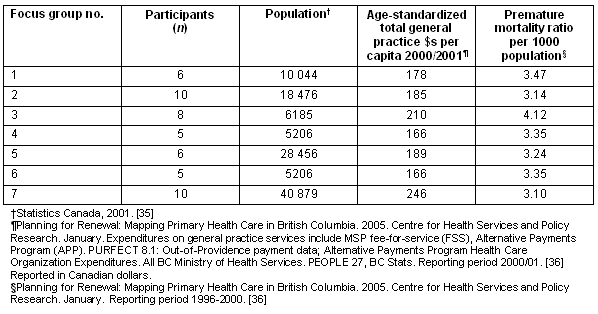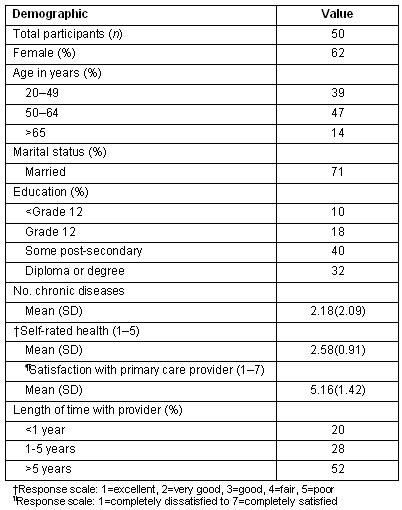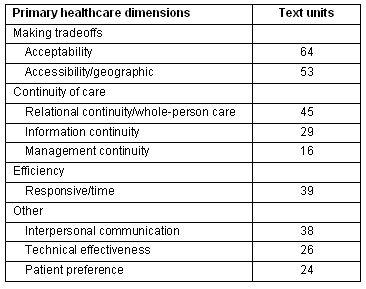Introduction
Equitable access to health care for all Canadians is a fundamental principle of the Canadian healthcare system1. Healthcare systems that fail to provide equitable access for diverse populations can increase the gap in health disparities2-4. Indeed, access to and utilization of primary healthcare (PHC) services is one pathway by which inequalities (geographic, economic, cultural) can influence population health5, and equitable access to health services continues to be a common concern across geographic locations. For universally available health services, examining how to deliver these services and make them accessible regardless of geographic location from providers' and patients' perspectives is needed. Studies have examined geographic access issues related to rural health care and services from the perspective of healthcare providers6,7. However, less is known about how geographic access to PHC contributes to health disparities from individuals' perspectives. The purpose of this study was to examine the perspectives of PHC of people who live in rural communities.
Primary health care can be defined as an approach to health policy and service provision that includes both services delivered to individuals (primary care services) and population-level, public health-type functions8. In terms of health service delivery, PHC is considered to be the place individuals first make contact with the healthcare system, and the first level of care that includes both clinical services and health promotion activities2,9. While the PHC sector may be equitably distributed at a population level10,11, at the community and individual level, any health service system disadvantages are exacerbated by population trends such as demographic aging and increased incidence of chronic illnesses7.
Part of Joseph & Cloutier's12 conceptual framework for examining health services in rural communities, particularly for older people, can be used as a heuristic method to conceptualize individual level interactions with PHC and to discover why health disparities may occur for rural people. In this conceptual framework, factors are specified that are influences at community and individual level. For individuals, there are three factors that influence the decision to use or not use available services; thus, meeting a recognized need will be influenced by: (i) the degree to which the service is perceived as important (what are the consequences if the need is unmet?); (ii) the perceived quality of the local service (is it of good quality?, are the people friendly?); and (iii) the accessibility (especially in physical terms) of the local service12. For rural communities in particular, there is a known 'distance decay' effect where there is lower use of services with increasing distance13,14. The distance decay effect is mediated by factors such as appropriate transportation15, social networks16 and the changing role of families in providing informal care17. However, little work has been done to examine how the relationships of or complexity of various factors for people living in rural communities affect access to and use of PHC services.
One way to examine the complexity of using PHC services and living in a rural community is to engage these residents in reflecting on their experiences. Their perspectives can be used to assess the quality of care delivered and how care and services could be improved18,19. As participants in healthcare delivery and reporters of their experiences in PHC, people living in rural communities can influence the quality of care in more direct ways, such as through their involvement in decisions about medical treatment or the allocation of resources to meet healthcare needs. Engaging PHC patients increases their adherence to a recommended treatment and understanding of their condition; thus, they are more likely to experience a better quality of life and greater satisfaction with the PHC20. Potential quality of care and system outcomes include enhanced consumer choice of provider and adherence to medical advice21-23, reduced complaints24 and fewer grievances25, a reduced number and seriousness of malpractice claims26,27, and improved actual and functional health outcomes22,28-30.
Methods
In order to examine patients' perspectives on how health services could be delivered equitably to rural communities, a descriptive qualitative study was conducted to identify dimensions of PHC deemed important to patients living in British Columbia (BC). Focus group methodology was used because this allows people sharing a similar geographic location (rural) to tell their stories and, in this case, to suggest ways in which the primary healthcare system could be improved. Seven focus groups (n = 50 people) were conducted in 6 rural communities across BC in order to examine participants' experiences in accessing and using PHC services31. In most communities only one focus group was conducted; the exception was when two focus groups were conducted in one community.
Rural communities were defined using 'non-metropolitan regions'; this was originally an American classification system adapted for Canadian non-metropolitan analysis by Ehrensaft32. Non-metropolitan regions take into account adjacency (or lack thereof) to a metropolitan area, and the type of settlement that predominates (eg small cities, small towns)33. Participating focus group sites were selected in consultation with representatives from each of the 5 BC regional health authorities and, to ensure variation, this was based on population health status and expenditures on family physicians. Table 1 provides details regarding focus group communities that could be classified as either non-metropolitan small city zones (20 000-49 999 people) or small-town zones (2500-19 999 people)33 that were not adjacent to a metropolitan area. Based on site selection, a random sample of telephone numbers was obtained from the Canadian Sampler Survey34 and used to recruit 6-9 potential participants per site. Participants were eligible if they: (i) were fluent in English; (ii) were aged between 18 and 90 years; and (iii) had visited a PHC provider within the past 2 years. All procedures were approved by the University of British Columbia's Behavioural Research Ethics Board.
Table 1: Characteristics of rural focus groups' communities

Focus groups were held in community centers at each site. Participants first completed a sociodemographic questionnaire (eg sex, age, education) that also contained questions about their general health and length of time with current PHC provider. Focus group questions were open-ended, and asked about participants' experiences with PHC and how they thought the PHC system could be improved. Each focus group lasted between 90 and 120 min and was conducted according to standard focus group procedures37. Groups were facilitated by a research team member, and all discussions were audio-taped and transcribed.
The Results-based Logic Model for Primary Health Care38 provided the conceptual framework for developing the coding scheme. This model or evaluation framework establishes the inputs (eg human or material resources), activities (work processes), outputs (products or services), and outcomes (eg acceptability or patient health) of PHC, and defines domains appropriate to understanding efficiency and effectiveness. Research team members independently read, re-read and coded the transcripts. In order to ensure quality a number of validity checks39 were undertaken. The team met on several different occasions to discuss emerging themes and codes until consensus was reached. Team members were reflective in their independent analysis and during discussions. Coding was iterative, refinements were made to the coding scheme, and codes were collapsed to represent more complex concepts. Next, definitions of the agreed upon codes were developed using a consensus approach among the team. Final coding was organized using Atlas TI (Scientific Software Development GmbH, Berlin, Germany; http://www.atlasti.com/), a qualitative software program. Throughout the analytic process, an audit trail was developed for all decisions39. Verification of the codes and the coded text occurred using both inductive and deductive methods40. Finally, the emerging findings were presented to the decision-makers responsible for providing PHC services.
Text units, defined as the continuous coded text of one focus group participant, are reported for the top 10 codes (Table 3). These were examined for frequency patterns in participants' discussion of priorities in assessing the quality of PHC. Additionally, coded data were compared and contrasted in order to produce thematic descriptions based on the rural participants' experiences with PHC41.
Results
Fifty people participated in the 7 focus groups with almost half (47%) aged 50-64 years. Sixty-two percent were women and 72% had some post secondary education (Table 2). On average, participants reported having two chronic diseases, and 80% had been patients of the same provider for at least one year.
Table 2: Rural community focus groups' participant demographics

Table 3 shows the coded text units, rank ordered according to the highest frequency of text units. This article focuses on the three main themes that emerged from the text units: (i) making tradeoffs; (ii) continuity of care; and (iii) efficiency across the health system.
Table 3: Coded text units for rural community focus groups (rank ordered by frequency)

Making tradeoffs
Participants discussed having to make tradeoffs in having their healthcare needs met between out-of-pocket costs and safety. For example, participants described access to PHC and other healthcare services (eg specialists and diagnostic tests) as inequitable: 'There is no possibility of me ever going to Vancouver [a large urban tertiary care center] to get any kind of care because I cannot afford it' (Rural Community Focus Group [RCFG] 7 Participant [P] 3). The reasons for perceived inequities included both the lack of available services in their home community and the costs and safety concerns associated with travel to obtain other health services. Although participants recognized the need to travel to access some PHC and PHC-related (eg diagnostic and preventive) and specialist services, they also discussed the continued need for meeting basic health care within their own communities. One stated, 'It's not realistic to get every single service in every single area...but we've got to have enough to get by...and then you can travel to other places' (RCFG 1 P 2).
Participants discussed the implications of not having services such as mental health, home care, physical therapy and secondary care services (eg radiology) available in their home community:
Every two weeks when the plaster was on for my broken arm, I had to travel to Prince George [largest community in Northern BC], wait and then get an X-ray taken. I was trying to figure out how to get to Prince George [from a rural community] for 7 am the next day...when you've got a broken arm it's darn hard to drive a standard transmission pick-up truck. (RCFG2 P1)
Some services were either not available often enough (eg home care, mental health) or participants had to drive to a regional center to access them. Indeed, some PHC interventions were compromised by the long distances traveled (45 min to 2 hours) by participants:
...prescribing massage therapy for migraines was wonderful. If I could have stayed [in the regional center] after the massage... but coming home on the bumpy roads, it was undone... (RCFG4 P3)
For these participants, it was a trade-off between acquiring needed health services and out-of-pocket costs. Participants in all communities recognized they had the financial resources to make these choices but that there were others in their communities who did not have this choice. Some of the services (eg massage therapy) do not come in the typical basket of PHC services but could be considered medically necessary in some cases (eg X-rays of broken bones) or related to prevention.
Participants also discussed having high out-of-pocket costs associated with necessary travel to regional centers (eg Vancouver) if referred for specialist care. Driving to obtain services was costly in terms of gas and lost worker productivity. Moreover, participants made tradeoffs between safety (eg hazardous driving conditions due to seasonal weather) and having healthcare needs go unmet:
We're only two hours away from [regional center], but it's not like two hours where there are places to stop along the way. There is nothing in between here and [regional center] (RCFG4 P3); andI was required to go to the physical therapist in [a regional center] and it was in the middle of winter and I refused to go. I'm not driving that road in the middle of winter. (RCFG7 P3)
Participants suggested that improved public transport or a shuttle bus service to would assist them to travel safely from their rural communities to regional centers of care.
Continuity of care
Patients defined three different types of continuity: (i) relational - the ongoing therapeutic relationship between a consumer and provider; (ii) informational - the use of information on past events and personal circumstances to make care appropriate; and (iii) management - a consistent and coherent approach to the management of a health condition42. Participants believed that the inability to maintain a continuous relationship with a provider contributed to challenges in maintaining people's health.
We've had doctors here for as little as a few months, locums will come in for three weeks sometimes....it's not as bad here as it was in the other northern community I lived.... I actually attribute a lot of my health problems to that I didn't get proper care through those years (RCFG4 P3).
Having a continuous relationship with a regular provider was important for participants across communities in order to 'feel comfortable' receiving care, having confidence in the provider's recommendations about treatments and developing trust. Building a positive and respectful relationship between the patient and provider was necessary before participants could engage with their PHC provider in following a treatment plan. However, participants described challenges in establishing relationships with healthcare providers. The turnover of providers in rural communities created difficulties in maintaining a continuous relationship, and this was particularly challenging for those needing continuous management for their chronic conditions.
I think here and in a lot of small towns, we've got a very high turnover of doctors...there's a half dozen or however many who've been here forever and the rest are sort of a revolving door. They're here for a year and then they're gone off... (RCFG 2 P 1).
Challenges with all three dimensions of continuity - management, information and relationship - were often described by those living in rural communities to be further compounded by the costs associated with travel. One participant described the lack of management continuity in their home community for her husband who had had heart surgery in a tertiary center, due to the turnover of PHC physicians, the lack of a cardiologist in the regional center and the high out-of-pocket travel expenses: 'I think that there needs to be continuity, in three years he hasn't even had his [heart] meds checked' (RCFG 6 PID unknown).
Efficiency across the health system
Participants noted that inefficiencies across the PHC sector and other services increased their out-of-pocket costs and decreased their productivity. Specifically, participants discussed the process of accessing diagnostic and other services as being inefficient. This often related to information and management continuity.
Why couldn't that X-ray have got done in [small nearby town with X-ray machine], sent by courier to the specialist and then he could look. [Instead] I have to come in [travel to the specialist], the specialist could have phoned [my family doctor] and I could been there.... My time and money are wasted (RCFG 2 P 1).
Some participants also perceived that the PHC system was not well-organized or efficient: '...you can only get your prescription for three months, so every three months you have to go back even though it's an ongoing prescription' (RCFG 5 P 1). Clinical prescribing guidelines could be examined to assess whether prescriptions could be provided for longer time periods for patients who met certain criteria. Additionally, participants discussed making some PHC services more available in their own rural communities through the expanded use of providers such as midwives, pharmacists and nurse practitioners.
Traveling between communities was an important cross-cutting theme common to the three main themes. While the need for travel outside rural residents' home communities for services is a reality, this creates a tension regarding safety, obtaining continuous care, and paying out-of-pocket travel expenses. Moreover, rural residents' need for personal transportation creates another barrier to accessing services.
Discussion
Poor PHC, reduced access to care and fewer resources increase avoidable hospitalization rates - one indicator of inequity in service provision43-45. These findings provide insight into how inequities in access to PHC and other healthcare services affect those living in rural communities. Access to and using PHC services is complex for rural residents. It depends on how seriously they perceive the need for care, whether they are able to obtain the required service in their home community, and whether they have the means (transportation or financial) to obtain it. While these issues exist for all individuals, regardless of geographic location, for rural residents there is a greater likelihood of having to travel outside their own community to regional health centers.
The value of these findings is that they provide specific suggestions for improving access and continuity of care. Not only is funding for PHC services in rural communities required by local jurisdictions, but so too is finding amenable solutions to structural barriers like travel and transportation. In some jurisdictions, such as in BC's Northern Health Authority, a bus service was created for out-of-town medical appointments. The Northern Health Connections program46 provides rural residents with subsidised transportation options (a user fee is required) and so reduces one of the costs associated with accessing PHC services not available in home communities. More can be achieved in increasing information and management continuity by encouraging uptake and use of such e-health systems as would allow rural residents to remain in their home community.
Unlike Berta and colleagues' findings47 that providers' technical and interpersonal communication skills are the top priorities in performance measurement in PHC, once our rural residents had access to PHC and related services they prioritized barriers to continuity of care and system inefficiencies. In many small communities, the choice of a provider for their technical or interpersonal communication skills is not within a rural resident's control. Moreover, rural residents are more frequently faced with having to make tradeoffs between using healthcare services and other priorities, such as personal safety.
As Joseph & Cloutier noted12 almost 20 years ago, providing health services to an aging rural population will present increasing challenges to jurisdictions mandated to provide equitable health care. Although this study only captured a small number of people living in rural communities, 71% of adults aged 60 to 79 years, and 82% of adults 80 years and older in Canada report having at least one chronic condition48. Moreover, one-third of people with one or more select chronic conditions reported using approximately 51% of family physician consultations, 55% of specialist consultations, 67% of nursing consultations and 72% of nights spent in a hospital. Clearly, chronic conditions are key drivers of healthcare service usage48.
Those in smaller communities are also challenged by higher PHC provider turnover, and in accessing services related to PHC, and this suggests that innovative use of technology would be acceptable to patients. Using innovative, multidisciplinary models of organizing and providing care may serve to decrease the gap in receipt of health services between rural and urban communities. One example of this is a relatively new model for Canadian rural communities: the delivery of PHC through group medical visits (GMV). Group medical visits can increase PHC accessibility for patients with a common diagnosis (eg diabetes), or for those who in a specific population (eg frail elderly people at risk for hospitalization). The GMVs offer routine PHC (eg examinations or prescriptions) with some group support and self-management education, thereby providing an opportunity for cohesive, coordinated primary, secondary and tertiary prevention and advice in a single appointment49-51. Evidence suggests that patients participating in GMVs have improved quality of care, such as increased capacity to manage their health that includes chronic disease management and nutrition52,53. Group medical visits could allow rural residents to obtain the medical and social support they need to stay in their communities. This model of care delivery, which is offered by a multidisciplinary team of providers, has recently been implemented in several rural BC communities.
The present study is not without limitations. While focus groups were held on different days and at differing times, most participants were older and had at least one chronic condition. However, these participants were likely to have had enough encounters with the PHC sector to ascertain which characteristics were most important. Only participants who spoke English and lived in BC were included in the study. However, BC is the third- or fourth-highest ranked province in Canada in terms of percentage of the population considered rural33 (the ranking depends on how rural is defined). Moreover, most people who speak English as a second language (eg Chinese, Punjabi) in Canada live in metropolitan regions. Immigrants, who are more likely to speak English as a second language, make up approximately only 12% of the rural population in Canada54. Future studies could examine PHC access and usage experiences in the many Aboriginal communities located in rural areas.
The present study suggests how individuals' health can be affected by geographic location. Most countries will face the challenge of aging rural communities where residents have one or more chronic conditions. And although each rural community is complex and dynamic and individuals may place differing values on the importance of needed PHC services, trade-offs will be made between competing priorities. An understanding of the structural barriers to continuity of care, and suggestions for increased efficiencies form part of the foundation for future studies into the equitability of rural health services.
Acknowledgements
The study was funded, in part, by the BC Ministry of Health. Dr Wong was supported by a career award from the National Institute of Aging (444918-31259) and a scholar award by the Michael Smith Foundation for Health Research (CI-SCH-051 (04-1)). Ms Regan was supported by the Canadian Institutes for Health Research TUTOR-PHC Fellowship and Doctoral Research Award, Michael Smith Foundation for Health Research Senior Graduate Studentship, Canadian Nurses Foundation Doctoral Scholarship, the Western Regional Training Center for Health Services Research and is a NEXUS trainee. The authors would also like to acknowledge all the focus group participants, those who helped facilitate this study in their communities, Ms Ella Young who helped collect the data and Dr Diane Watson for their helpful insights. The conclusions are those of the authors and no official endorsement by the BC Ministry of Health or National Institute of Aging is intended or should be inferred.
References
1. Department of Justice Canada. Canada Health Act. (Online) 2009. Available: http://laws.justice.gc.ca/en/c-6/text.html (Accessed 1 October 2006).
2. Starfield B. Primary care: balancing health needs, services, and technology. New York, NY: Oxford University Press, 1998.
3. Weissman J, Gatsonis C, Epstein A. Rates of avoidable hospitalization by insurance status in Massachusetts and Maryland. JAMA 1992; 268(17): 2388-2394.
4. Health Canada. Access to health services for underserved populations in Canada. In: H Canada (Ed). In certain circumstances: issues in equity and responsiveness in access to health care in Canada. Ottawa, ON: Health Canada, 2001; 1-60.
5. Shi L. Health care spending, delivery, and outcome in developed countries: a cross-national comparison. American Journal of Medical Quality 1997; 12: 83-93.
6. Ahmad F, Stewart D, Cameron J, Hyman I. Rural physicians' perspectives on cervical and breast cancer screening: a gender-based analysis. Journal of Womens Health Gendered Based Medicine 2001; 10(2): 201-208.
7. Cloutier-Fisher D, Joseph A. Long-term care restructuring in rural Ontario: retrieving community service user and provider narratives. Social Science and Medicine 2000; 50(7-8): 1037-1045.
8. Muldoon L, Hogg W, Levitt M. Primary care (PC) and primary health care (PHC). What is the difference? Canadian Journal of Public Health 2006; 97: 409-411.
9. Shortt R, Dorland J. Implementing primary care reform. Kingston, ON: McGill University Press, 2004.
10. St John P, Havens B, van Ineveld C, Finlayson M. Rural-urban differences in health status of elderly Manitobans. Canadian Journal of Rural Medicine 2002; 7(2): 89-93.
11. Mainous A, Kohrs F. A comparison of health status between rural and urban adults. Journal of Community Health 1995; 20(5): 423-431.
12. Joseph A, Cloutier D. A framework for modeling the consumption of health services by the rural elderly. Social Science and Medicine 1990; 30(1): 45-52.
13. Jones A, Bentham G, Harrison B, Badminton R, Wareham N. Accessibility and health service utilization for asthma in Norfolk, England. Journal of Public Health Medicine 1998; 20(3): 312-317.
14. Whitehouse C. Effects of distance from surgery on consultation rates in urban general practice. BMJ(Clinical Research Edition) 1985; 290: 359-362.
15. Field K, Briggs D. Socio-economic and locational determinants of accessibility and utilization of primary health care. Health and Social Care in the Community 2001; 9(5): 294-308.
16. Richards H, Reid M, Watt G. Socioeconomic variations in responses to chest pain. BMJ 2002; 324: 1308-1310.
17. Hanlon N, Halseth G, Clasby R, Pow V. The place embeddedness of social care: restructuring work and welfare in Mackenzie, BC. Health & Place 2007; 13(2): 466-81.
18. Hadorn D. The role of public values in setting health care priorities. Social Science and Medicine 1991; 32(7): 773-781.
19. Wensing M, Jung HP, Mainz J, Olesen F, Grol R. A systematic review of the literature on patient priorities for general practice care. Part 1: description of the research domain. Social Science and Medicine 1998; 47(10): 1573-1588.
20. Davis K, Schoenbaum S, Audet A-M. A 2020 vision of patient-centered primary care. Journal of General Internal Medicine 2005; 20: 953-957.
21. Golin C, DiMatteo M, Gelberg L. The role of patient participation in the doctor visit: implications for adherence to diabetes care. Diabetes Care 1996; 19: 1153-1164.
22. Brown R. Behavioural issues in asthma management. Pediatric Pulmonology Supplement 2001; 21: 26-30.
23. Bartlett J. Addressing the challenges of adherence. Journal of Acquired Immune Deficiency Syndrome 2002; 1: S2-S10.
24. Taylor D, Wolfe R, Cameron P. Complaints from emergency department patients largely result from treatment and communication problems. Emergency Medicine 2002; 14: 43-49.
25. Halperin E. Grievances against physicians: 11 years' experience of a medical society grievance committee. Western Journal of Medicine 2000; 173: 235-238.
26. Hickson G, Clayton E, Githens P, Sloan F. Factors that prompted families to file medical malpractice claims following perinatal injuries. JAMA 1992; 267: 1359-1363.
27. Hickson G, Federspiel C, Pichert J, Miller C, Gauld-Jaeger J, Bost P. Patient complaints and malpractice risk. JAMA 2002; 287: 2951-2957.
28. Maly R, bourque L, Engelhardt R. A randomized controlled trial of facilitating information giving to patients with chronic medical conditions: effects on outcomes of care. Journal of Family Practice 1999; 48: 356-363.
29. Covinsky K, Rosenthal G, Chren M, Justice A, Fortinsky R, Palmer RM et al. The relation between health status changes and patient satisfaction in older hospitalized medical patients. Journal of General Internal Medicine 1998; 13: 223-229.
30. Cleary P, Edgman-Levitan S. Health care quality: incorporating consumer perspectives. Journal of the American Medical Association 1997; 278(19): 1608-1611.
31. Wong S, Watson D, Regan S, Young E. Public perspectives of primary health care. Healthcare Policy 2008; 3(3): 89-104.
32. Ehrensaft P, Beeman J. Distance and diversity in nonmetropolitan economies. In: R Bollman (Ed.). Rural and Small Town Canada. Toronto, ON: Thompson Educational, 1992.
33. du Plessis V, Beshiri R, Bollman R, Clemenson H. Definitions of 'Rural'. Ottawa, ON: Statistics Canada, 2002.
34. ASDE. ASDE survey sampler. (Online) no date. Available: http://www.surveysampler.com/ (Accessed 13 September 2006).
35. BC Statistics. Population estimates, standard ag. (Online) 2001. Available: http://www.bcstats.gov.bc.ca/data/pop/pop/dynamic/ProvPop/Query.asp?category=Prov&type=1&topic=Estimatesroups (Accessed 17 March 2009).
36. Watson DE, Krueger H, Mooney D, Black C. Planning for renewal: mapping primary health care in British Columbia. Vancouver, BC: Center for Health Services and Policy Research, 2005.
37. Krueger R. Focus groups: a practical guide for applied research, 2 edn. Thousand Oaks, CA: Sage, 1994.
38. Watson D, Broemeling A, Reid R, Black C. A results-based logic model for primary health care: laying an evidence-based foundation to guide performance measurement, monitoring, and evaluation. Vancouver, BC: Center for Health Services and Policy Research, 2004.
39. Mays N, Pope C. Assessing quality in qualitative research. BMJ 2000; 320: 50-52.
40. Strauss A. Qualitative analysis for social scientists. New York, NY: Cambridge University Press, 1995.
41. Sandelowski M, Barroso J. Classifying the findings in qualitative studies. Qualitative Health Research 2003; 13(7): 905-923.
42. Haggerty J, Burge F, Lévesque J-F, Gass D, Pineault R, Beaulieu M-D et al. Operational definitions of attributes of primary health care to be evaluated: consensus among Canadian experts. Annals of Family Medicine 2007; 5: 336-344.
43. Parchman M, Culler S. Primary-care physicians and avoidable hospitalizations. Journal of Family Practice 1994; 39(2): 123-128.
44. Kozak L, Hall M, Owings M. Trends in avoidable hospitalizations, 1980-1998. Health Affairs 2001; 20(2): 225-232.
45. Cloutier-Fisher D, Penning M, Zheng C, Druyts E-B. The devil is in the details: trends in avoidable hospitalization rates by geography in British Columbia, 1990-2000. Biomed Central Health Services Research 2006; 6(104): Available: http://www.biomedcentral.com/content/pdf/1472-6963-6-104.pdf (Accessed 17 March 2009).
46. Northern Health. Northern Health Connections. (Online) 2008. Available: http://www.northernhealth.ca/Your_Health/Programs/NH_Connections/ (Accessed 1 February 2009).
47. Berta W, Barnsley J, Brown A, Murray M. In the eyes of the beholder: population perspectives on performance priorities for primary care in Canada. Healthcare Policy 2008; 4(2): 86-100.
48. Broemeling A, Watson D, Prebtani F. Population patters of chronic health conditions, co-morbidity and healthcare use in Canada: implications for policy and practice. Healthcare Quarterly 2008; 11(3): 70-76.
49. Bodenheimer T, Wagner E, Grumbach K. Improving primary care for patients with chronic illness. JAMA 2002; 288(14): 1775-1779.
50. Masley S, Sokoloff J, Hawes C. Planning group visits for high-risk patients. Family Practice Management 2000; 7(6): 33-37.
51. Noffsinger E, Scott J. Understanding today's group visit models. Permanente Journal 2007 2000; 4(2): Available: http://www.biomedcentral.com/content/pdf/1472-6963-6-104.pdf (Accessed 17 March 2009).
52. Dodds M, Nicholson L, Muse B, Osborn L. Group health supervision visits more effective than individual visits in delivering health care information. Pediatrics 1992; 91: 668-670.
53. Scott J, Conner D, Venhor I, Gade G, McKenzie M, Kramer AM et al. Effectiveness of a group outpatient visit model for chronically ill older health maintenance organization members: a 2-year randomized trial of the cooperative health care clinic. Journal of American Geriatric Society 2004; 52(9): 1463-1470.
54. Beshiri R, Alfred E. Immigrants in rural Canada. Ottawa, ON: Statistics Canada, 2002.

